https://www.vice.com/en_us/article/9kx4z8/revealed-this-is-palantirs-top-secret-user-manual-for-cops
[size=41]R[/size]
evealed: This Is Palantir’s Top-Secret User Manual for CopsMotherboard obtained a Palantir user manual through a public records request, and it gives unprecedented insight into how the company logs and tracks individuals.
By Caroline Haskins
Jul 12 2019, 8:13am
ShareTweet
IMAGE: JASON ALDEN/BLOOMBERG VIA GETTY IMAGES
Palantir is one of the most significant and secretive companies in big data analysis. The company acts as an information management service for Immigrations and Customs Enforcement, corporations like JP Morgan and Airbus, and dozens of other local, state, and federal agencies. It’s been described by scholars as a “secondary surveillance network,” since it extensively catalogs and maps interpersonal relationships between individuals, even those who aren't suspected of a crime.
Palantir software is instrumental to the operations of ICE, which is planning one of the largest-ever targeted immigration enforcement raids this weekend on thousands of undocumented families. Activists argue raids of this scale would be impossible without software like Palantir. But few people outside the company and its customers know how its software works or what its specific capabilities and user interfaces are.
Through a public record request, Motherboard has obtained a user manual that gives unprecedented insight into Palantir Gotham (Palantir’s other services, Palantir Foundry, is an enterprise data platform), which is used by law enforcement agencies like the Northern California Regional Intelligence Center. The NCRIC serves around 300 communities in northern California and is what is known as a "fusion center," a Department of Homeland Security intelligence center that aggregates and investigates informationfrom state, local, and federal agencies, as well as some private entities, into large databases that can be searched using software like Palantir.
Fusion centers have become a target of civil liberties groups in part because they collect and aggregate data from so many different public and private entities. The US Department of Justice’s Fusion Center Guidelines list the following as collection targets:
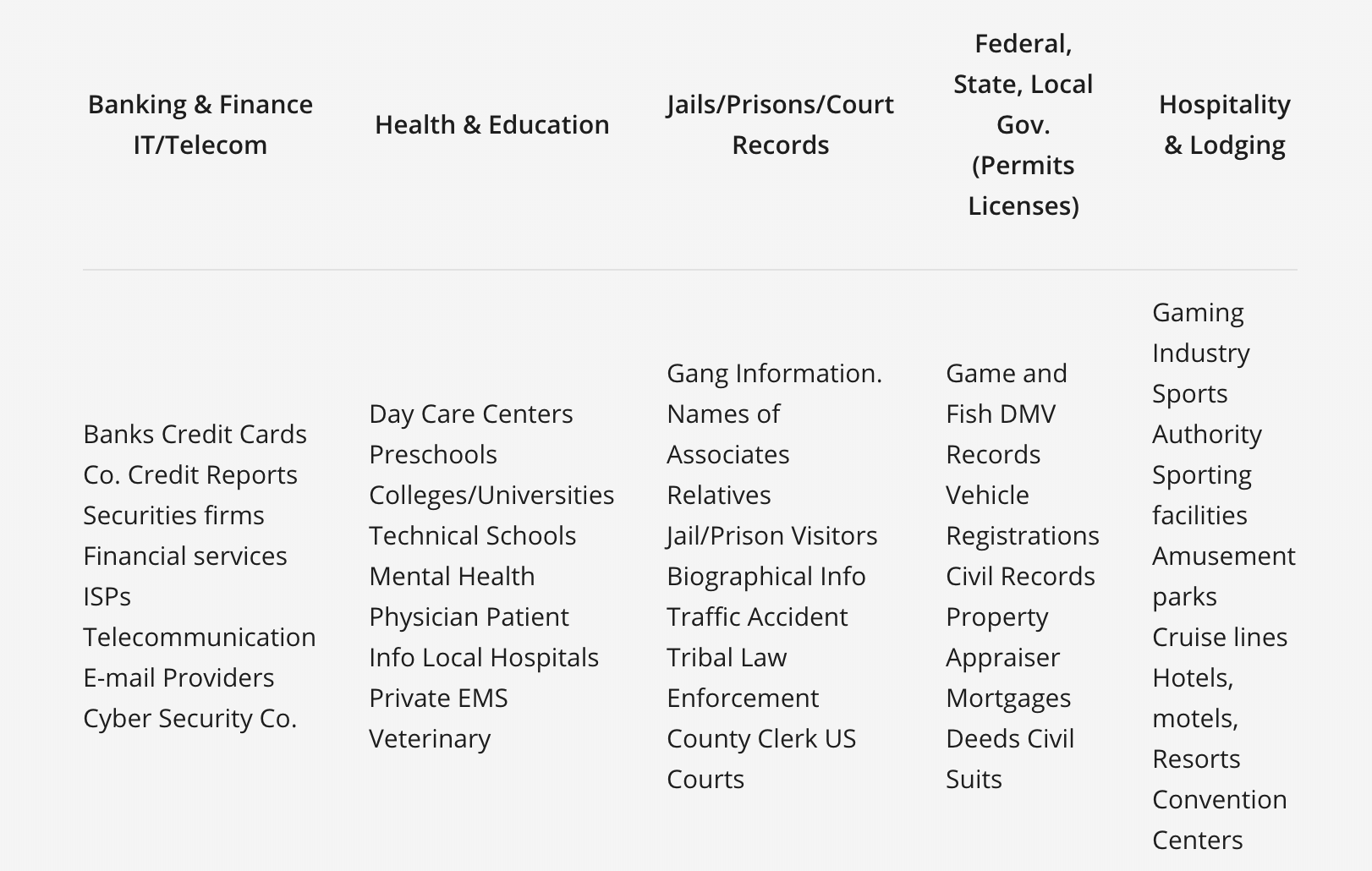
[size=10]DATA VIA US DEPARTMENT OF JUSTICE. CHART VIA ELECTRONIC INFORMATION PRIVACY CENTER.
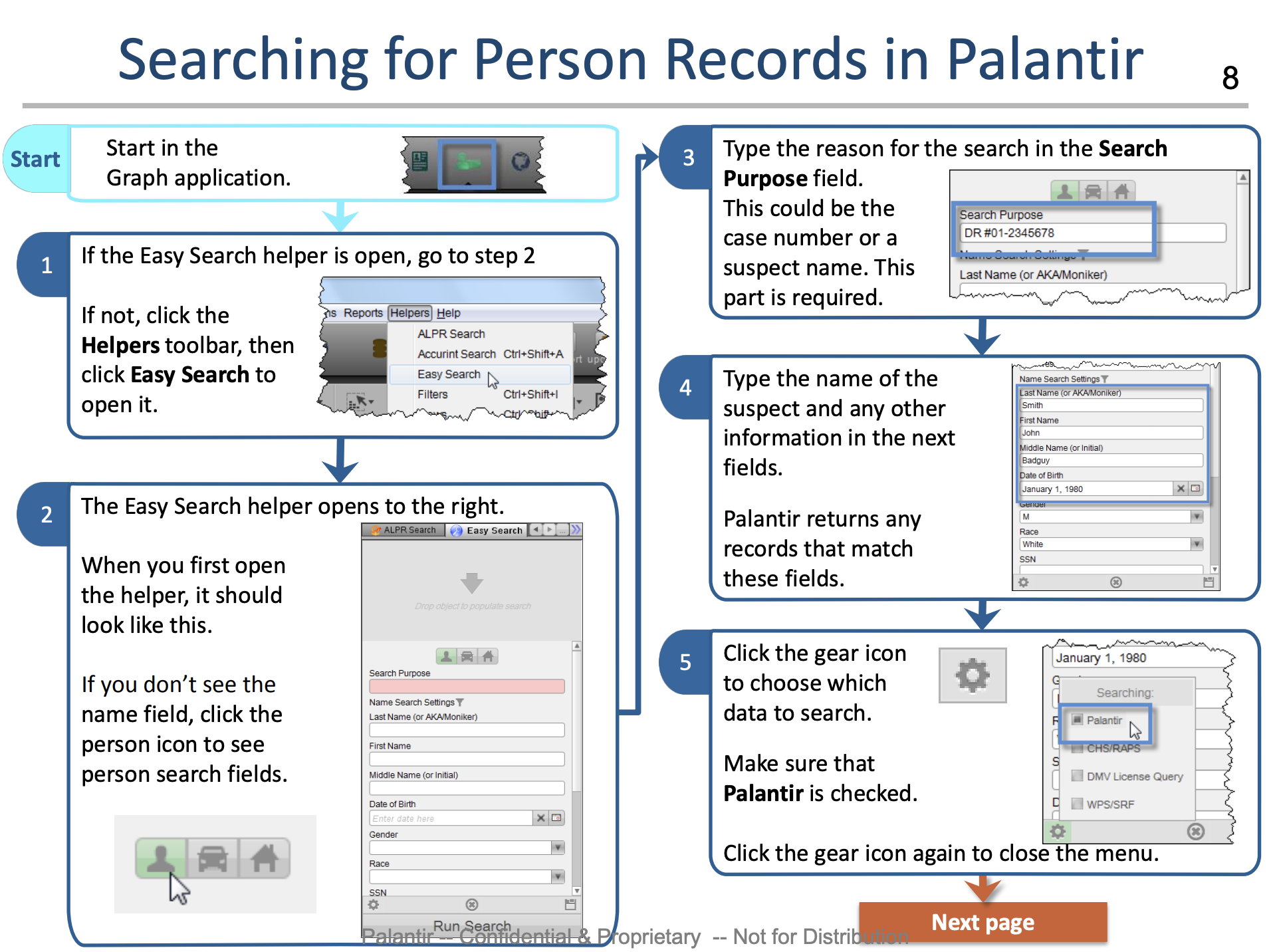
A FLOW CHART THAT EXPLAINS HOW COPS CAN BEGIN TO SEARCH FOR RECORDS RELATING TO A SINGLE PERSON.
The guide doesn’t just show how Gotham works. It also shows how police are instructed to use the software. This guide seems to be specifically made by Palantir for the California law enforcement because it includes examples specific to California. We don’t know exactly what information is excluded, or what changes have been made since the document was first created. The first eight pages that we received in response to our request is undated, but the remaining twenty-one pages were copyrighted in 2016. (Palantir did not respond to multiple requests for comment.)
The Palantir user guide shows that police can start with almost no information about a person of interest and instantly know extremely intimate details about their lives. The capabilities are staggering, according to the guide:
[/size]
- If police have a name that’s associated with a license plate, they can use automatic license plate reader data to find out where they’ve been, and when they’ve been there. This can give a complete account of where someone has driven over any time period.
- With a name, police can also find a person's email address, phone numbers, current and previous addresses, bank accounts, social security number(s), business relationships, family relationships, and license information like height, weight, and eye color, as long as it's in the agency's database.
- The software can map out a person's family members and business associates of a suspect, and theoretically, find the above information about them, too.
[size][size]
All of this information is aggregated and synthesized in a way that gives law enforcement nearly omniscient knowledge over any suspect they decide to surveil.
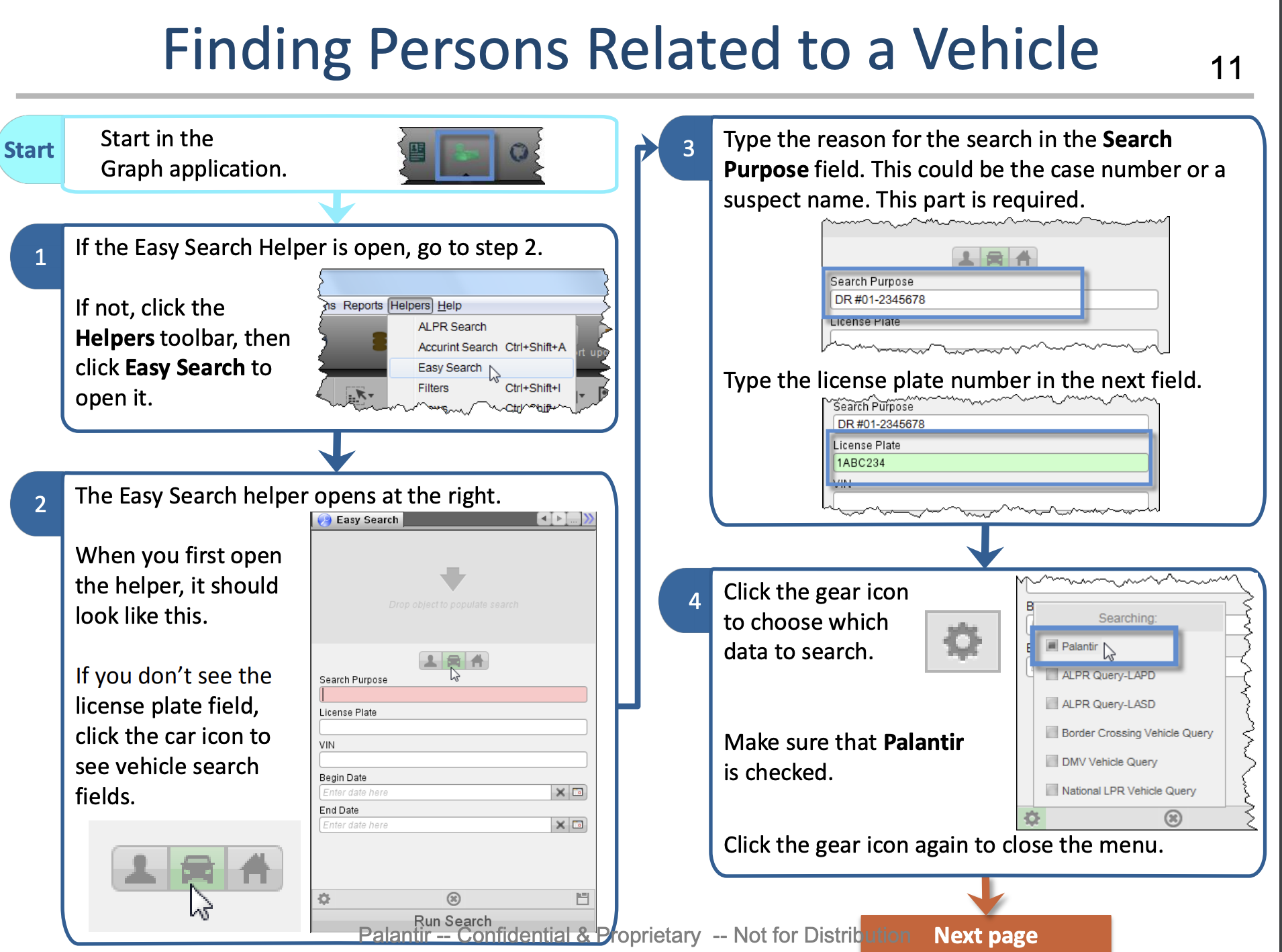 AN INSTRUCTIONAL FLOWCHART SHOWING HOW TO SEARCH FOR PEOPLE TIED TO A SPECIFIC VEHICLE OR LICENSE PLATE.
AN INSTRUCTIONAL FLOWCHART SHOWING HOW TO SEARCH FOR PEOPLE TIED TO A SPECIFIC VEHICLE OR LICENSE PLATE.TERMS TO KNOW
Most of the Palantir guide is written in the company’s technical language, so it can be hard to parse if you haven't used the software or aren't familiar with it. Here are the important terms to know:
OBJECTS: Any piece of data. This data could be a name, address, phone number, bank account number, etc.
HISTOGRAM: A chart. Specifically, a chart that looks like a web and makes connections between things. This feature kind of looks like the "detective wall" trope from TV and movies, but since it’s digitized, it’s much more fast, powerful, and dense.
ALPR/AUTOMATIC LICENSE PLATE READER: A camera that takes pictures of cars and license plates. They’re usually located at toll booths, or intersections on heavily trafficked roads, though police also have mobile versions of them and massive databases of license plate information. Each city in California has different ALPR privacy policies about how the information can be used and shared.
HEATMAP: A map that shows how many things there are in a particular area. A higher concentration of things is usually shown in a darker or richer color. Palantir advertises Gotham as a tool that transforms huge amounts of data into actionable maps for police investigations.
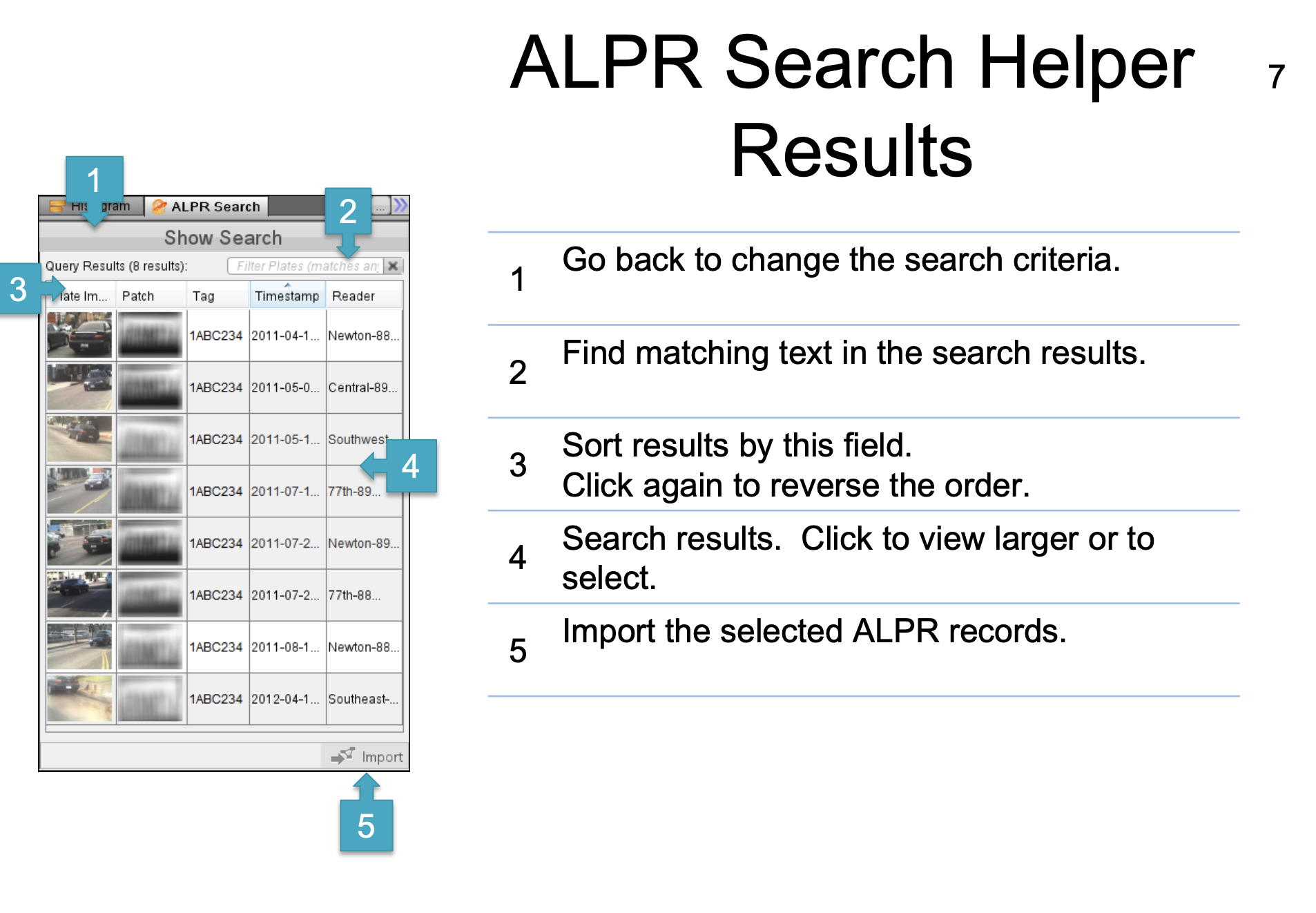 SEARCH RESULTS SHOWING THAT A SINGLE LICENSE PLATE CAN BE TRACKED AROUND THE STATE USING AUTOMATIC LICENSE PLATE READER DATA.
SEARCH RESULTS SHOWING THAT A SINGLE LICENSE PLATE CAN BE TRACKED AROUND THE STATE USING AUTOMATIC LICENSE PLATE READER DATA.THE DATA
All data points in Palantir are referred to as “Objects,” and these objects can be practically anything. But they boil down to three main categories: Entities, Events, and Documents. The possibilities of these categories are shown below.
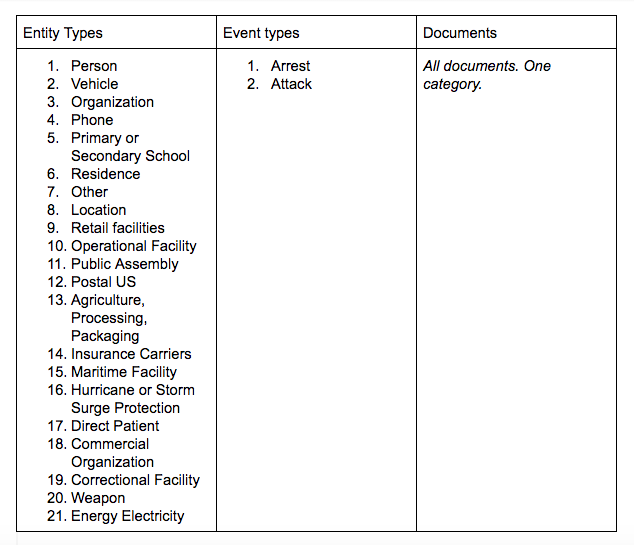 IMAGE: CHART OF OBJECT TYPES BASED ON DOCUMENT ACQUIRED BY MOTHERBOARD.
IMAGE: CHART OF OBJECT TYPES BASED ON DOCUMENT ACQUIRED BY MOTHERBOARD.The “Person” Entity Type doesn’t just include a person’s name. It also includes their emails, bank account numbers, phone numbers, current and previous addresses, social security number(s), and driver’s license data such as height, weight, eye color, and date of birth. (The email address example shown in the user guide is jbg01@DownWithTheUS.org.)
 IMAGE: ZOOMED-IN SCREENSHOT FROM THE PALANTIR USER GUIDE.
IMAGE: ZOOMED-IN SCREENSHOT FROM THE PALANTIR USER GUIDE.There’s also “Property Types”—which basically list different traits that can be attributed to Objects, or data points. The different Property Types are:
[/size][/size][list="box-sizing: inherit; margin-right: auto; margin-bottom: 30px; margin-left: auto; padding-right: 0px; padding-left: 0px; list-style-position: outside; font-size: 18px; max-width: 640px;"]
[*]Label
[*]Data Source
[*]Agency
[*]Address
[*]Data Range and Location
[*]Date
[*]Incident Type
[*]Geographic Area
[*]Incident Number
[*]Incident Disposition
[*]Incident Status
[*]Cross Street
[*]Comments
[*]Phone Number
[*]Location Name
[*]Name
[*]License Plate
[*]Gender
[/list]
[size][size]
The Palantir guide shows that this data is pulled from several different management systems at once. For instance, a Palantir screenshot included in the guide show that the NCRIC lets police pull from the record management systems of the San Mateo and Palo Alto Police Departments. This exemplifies Palantir's selling point: the system can synthesize enormous amounts of data from various sources. Palantir can also make connections across that data, making it accessible for users in a way that would be extremely time-intensive to do manually.
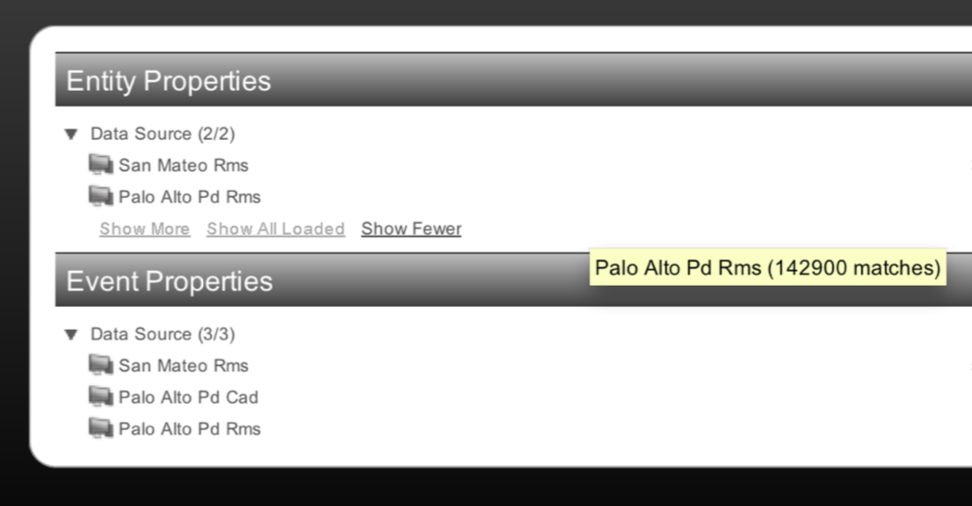 IMAGE: ZOOMED-IN SCREENSHOT OF THE PALANTIR OBJECT EXPLORER SECTION OF THE USER GUIDE.
IMAGE: ZOOMED-IN SCREENSHOT OF THE PALANTIR OBJECT EXPLORER SECTION OF THE USER GUIDE.In order for Palantir to work, it has to be fed data. This can mean public records like business registries, birth certificates, and marriage records, or police records like warrants and parole sheets. Palantir would need other data sources to give police access to information like emails and bank account numbers.
“Palantir Law Enforcement supports existing case management systems, evidence management systems, arrest records, warrant data, subpoenaed data, RMS or other crime-reporting data, Computer Aided Dispatch (CAD) data, federal repositories, gang intelligence, suspicious activity reports, Automated License Plate Reader (ALPR) data, and unstructured data such as document repositories and emails,” Palantir’s website says.
Some data sources—like marriage, divorce, birth, and business records—also implicate other people that are associated with a person personally or through family. So when police are investigating a person, they’re not just collecting a dragnet of emails, phone numbers, business relationships, travel histories, etc. about
one suspect. They’re also collecting information for people who are associated with this suspect.
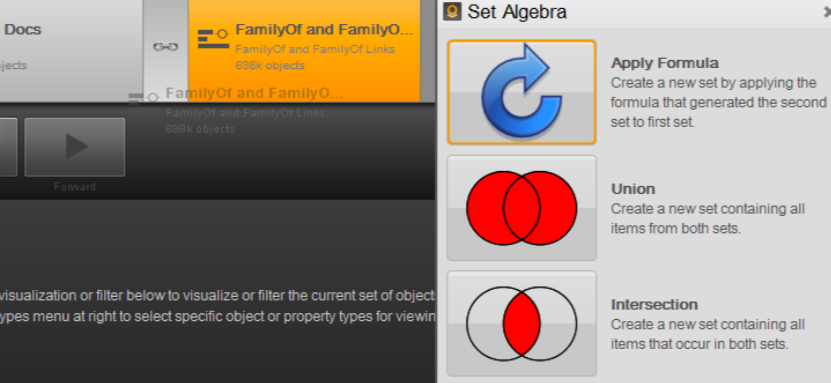 IMAGE: ZOOMED-IN SCREENSHOT OF THE PALANTIR OBJECT EXPLORER SECTION OF THE USER GUIDE.
IMAGE: ZOOMED-IN SCREENSHOT OF THE PALANTIR OBJECT EXPLORER SECTION OF THE USER GUIDE.SEARCHES
The guide explains how to make two types of searches: people record searches, and vehicle record searches.
With the people record search, police can start out with a person’s name. Police can also input a phone number (with or without area code), a license plate number, or the dates of cases associated with that person. The name that the Palantir guide uses as an example is "John Badguy Smith."
“The results that appear are from LAPD and LASD data sources,” the Palantir guide says, “and include person records linked to crimes, citations, and arrests.”
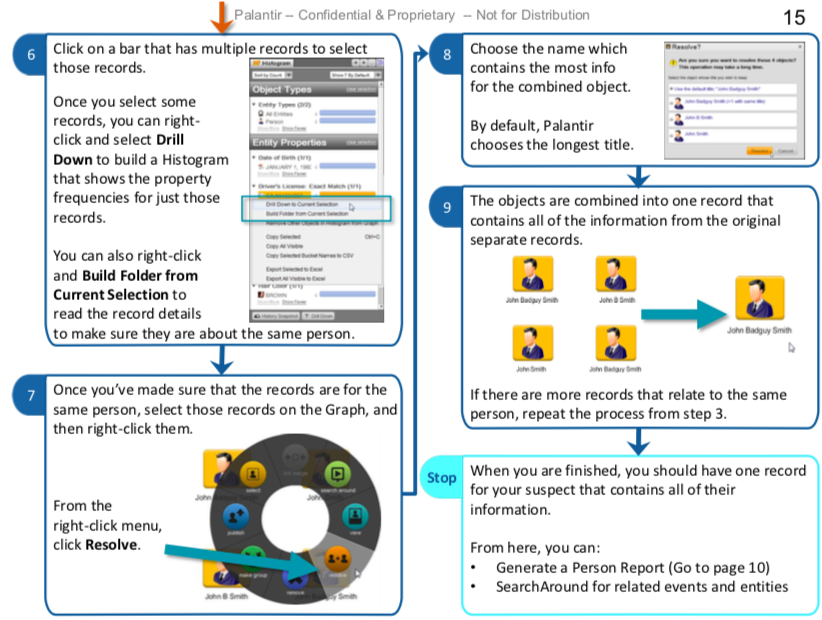
With the vehicle record search, police start by entering a license plate number. The results spit back any and all relevant information about that vehicle, and Palantir gives police the option of mapping or visualizing this information.
“The results show if the vehicle appeared in any crimes, arrests, field interviews, incidents, or citations, across both LAPD and LASD sources simultaneously,” the Palantir guide says.
TOOLSThe Palantir user guide also explains how to use three types of tools: the Histogram tool, the Map tool, and the Object Explorer tool. These tools all let police graph, map, visualize, and connect dozens of different types of data points. So, police can chart the relationships between individuals. Police can click on an individual on this chart and see everything about them: their email addresses, their bank account information, their license information, etc. Police can also put current addresses, previous addresses, locations of a suspected crime, work locations, family addresses, and travel history (as captured by ALPR-cameras) on a map.
Histogram ToolThe Histogram tool, as stated by the Palantir guide, helps police find “correlations” and “trends” between different Objects, or data points. This can help police decipher a person’s behavior. Police can also create “Virtual Dossiers” at the end of their investigations, which centralizes their analysis into a single place.
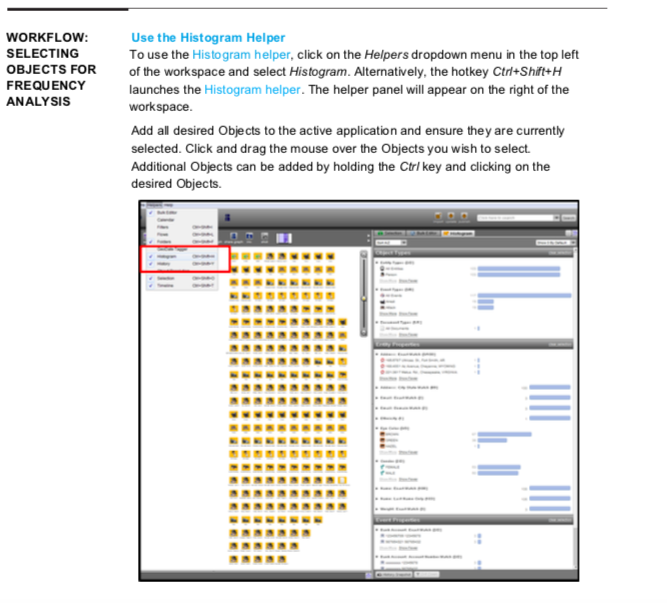 IMAGE: PALANTIR HISTOGRAM HELPER SECTION OF THE USER GUIDE.Map Tool
IMAGE: PALANTIR HISTOGRAM HELPER SECTION OF THE USER GUIDE.Map ToolThe Map tool lets police do three things: complete “Geosearches,” create “Heatmaps,” and search an Automatic License Plate Reader (ALPR) database.
Geosearches lets police see Objects, visually, within a certain radius on a map.
“The purple radius, polygon, route, or recent buttons allow you to draw a shape and search for objects/properties that are within the search area,” the Palantir guide says.
Heatmaps show the concentration of Objects on a map. Using a Legend tool, police can adjust the coloring and display of objects on the map.
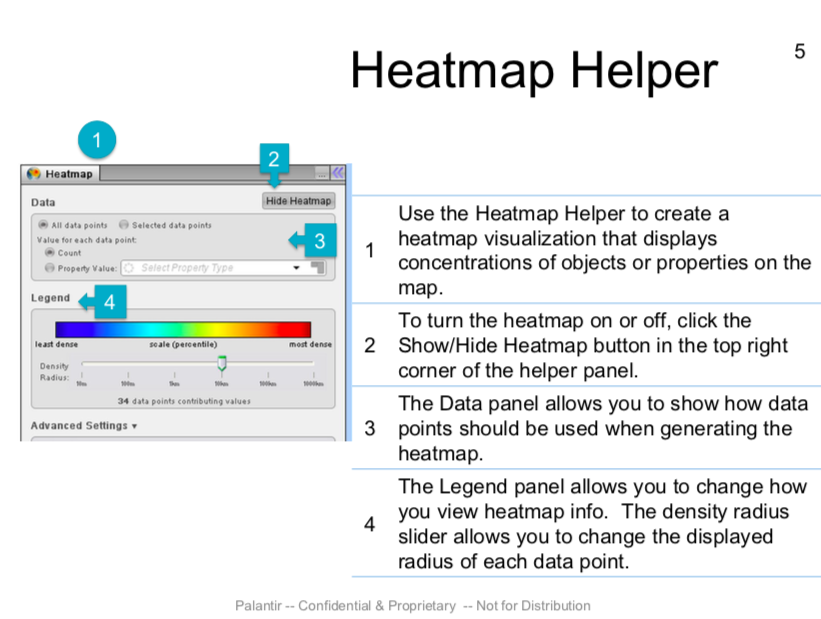 IMAGE: PALANTIR HEATMAP HELPER SECTION OF THE USER GUIDE.
IMAGE: PALANTIR HEATMAP HELPER SECTION OF THE USER GUIDE.The ALPR search, meanwhile, lets police view license plate data captured within a certain search radius on the map. Police have to first enter a search purpose, which can be a “a DR or case number,” according to the guide. Then, police have to enter the center of their search radius, and a license plate number they want to search. Police can, optionally, select a date range they want to search.
The results show images of the license plates as captured, the car associated with the license plate, time stamps, and the location that the license plate information was captured (Image of this is near the top of the article.)
Object ExplorerThe Object Explorer is a comprehensive analysis tool that lets police filter, sort, map, analyze, and export dozens of different data points. A huge part of the Object Explorer is visualizing data, which can be done in four main ways: numeric charts, histograms, timelines, and pie charts. The Palantir guide explains that depending on which Objects police are analyzing, the appropriate visualization tool may vary.
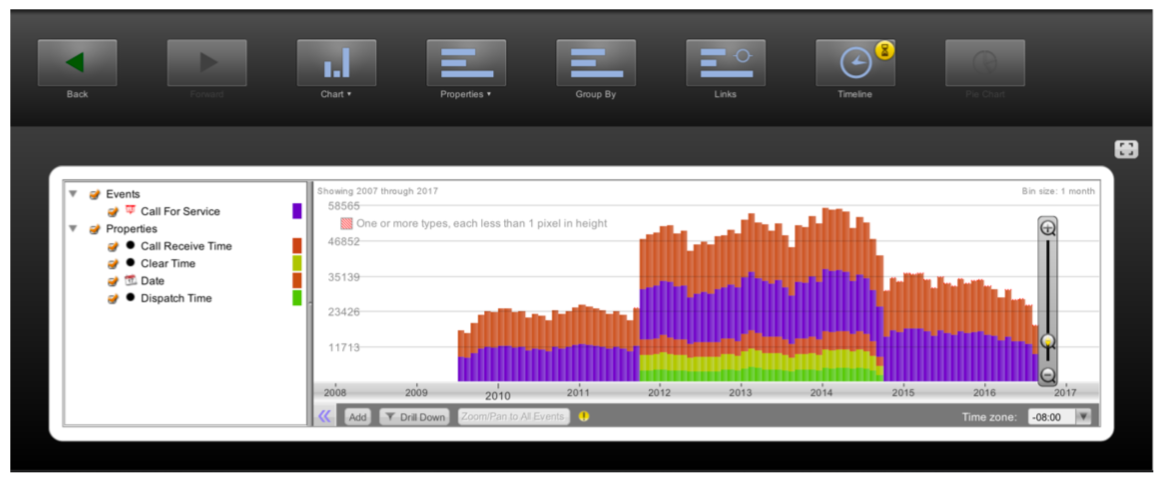 IMAGE: PALANTIR “TIMELINE” TOOL IN THE OBJECT EXPLORER.
IMAGE: PALANTIR “TIMELINE” TOOL IN THE OBJECT EXPLORER.The document obtained by Motherboard for this story is public and viewable on DocumentCloud.[/size][/size]





